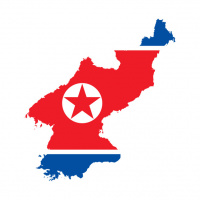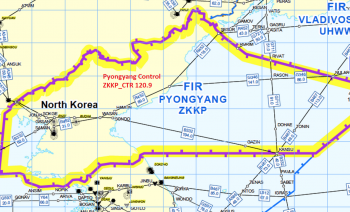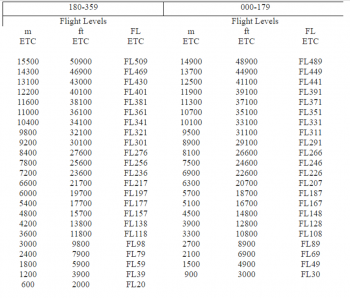Difference between revisions of "ZKKP Pyongyang FIR"
(→Japan LOA) |
|||
| (7 intermediate revisions by one other user not shown) | |||
| Line 9: | Line 9: | ||
'''Note''': ''Please keep in mind, IVAO stresses that our network is at global peace without any conflicts between nations. We also strive to simulate realism. So, while it is ok to respect the prohibited airspace at the DMZ between the DPRK and ROK, on IVAO, direct flights are permissible between the two nations. At no time shall any war simulation be performed in Korean airspace as this is a huge violation against IVAO rules and regulations. That being said, enjoy Pyongyang Control'' | '''Note''': ''Please keep in mind, IVAO stresses that our network is at global peace without any conflicts between nations. We also strive to simulate realism. So, while it is ok to respect the prohibited airspace at the DMZ between the DPRK and ROK, on IVAO, direct flights are permissible between the two nations. At no time shall any war simulation be performed in Korean airspace as this is a huge violation against IVAO rules and regulations. That being said, enjoy Pyongyang Control'' | ||
| + | == Sector File == | ||
| + | [https://hk.ivao.aero/download/sector/sector_kp_1711.zip Pyongyang FIR IVAC1 Sector] | ||
== Airspace Overview == | == Airspace Overview == | ||
| Line 90: | Line 92: | ||
[[File:Chinese meters.png|350px]] | [[File:Chinese meters.png|350px]] | ||
=== South Korea LOA === | === South Korea LOA === | ||
| + | See [[RKRR Incheon FIR]] for more information on South Korean airspace. | ||
| + | |||
| + | The Democratic People's Republic of Korea (DPRK, North Korea) and the Republic of Korea (ROK, South Korea) are at a friendly, peace state on IVAO per the rules and regulations R&R 1.3, as stated below: | ||
| + | |||
| + | <code>1.3 - When simulating real world aviation in the IVAO environment, we will avoid, at any price, to simulate or to become involved in real world ethnical, political and religious conflicts and problems. We also will not allow the simulation of any form of aggression or war. IVAO is an entertaining and educational network where every world citizen, without any exception, is welcome to join the fun and pursue there virtual aviation experience</code> | ||
| + | |||
| + | However, the IVAO XE Division will still respect the prohibited airspace from both RK and ZK covering the DMZ. Meaning, a controller can prohibit VFR flight through crossing the DMZ, but if a pilot requests to fly IFR direct from South Korea to North Korea with a route that will pass over the DMZ prohibited areas, traffic permitting, Pyongyang control can approve this to promote rule 1.3. | ||
| + | |||
| + | In the real world, flights sometimes do take place direct from RKSI to ZKPY. The realistic routes to be filed and flown are: | ||
| + | |||
| + | <code>RKSI NOPIK Y697 GONAV Y644 AGAVO G597 DONVO A326 SANKO B332 TOMUK B332 PONIL W1 GK ZKPY </code> | ||
| + | |||
| + | (Note, NOPIK used if RKSI is using 33L, 33R, or 34. Replace NOPIK With BINIL if 15L, 15R, and 16 are in use) | ||
| + | |||
| + | <code>ZKPY BODOK B332 PONIL B332 TOMUK B332 SANKO A326 DONVO G597 AGAVO Y644 REBIT RKSI </code> | ||
| + | |||
| + | For aircraft transitioning Pyongyang airspace, handoffs shall be made at or before '''KANSU''' from the Y233, B467-Y437, or B332-Z56 airways. North Korea has adapted RVSM airspace and flight levels can be used, however, meters are also sometimes used depending on the controller and pilot. | ||
| + | |||
| + | Direct handoffs can be made at '''MESOV''' to join the N513 or L771 airspace, if Pyongyang Control approves it. | ||
| + | |||
| + | All handoffs to Incheon will be given to RKKP_E_CTR or RKKP_CTR (Incheon Control). DMZ transitions must always be pre-coordinated with both Incheon and Pyongyang, if online. | ||
| + | |||
| + | At no time may war simulation, military exercises, or military aircraft may be done online per IVAO R&R 1.3 due to this politically sensitive area. | ||
| + | |||
| + | Enroute handoffs will be given at '''KANSU'''. Direct handoffs can be made at '''MESOV'''. If aircraft is cruising at a meter level, change to a feet FL. All handoffs from South Korea will be given at flight levels only. Follow the Russian and Chinese LOA guide for meters coordination. | ||
| − | |||
| − | === | + | === Pyongyang Arrivals === |
| + | === ZKPY Pyongyang Sunan Int'l === | ||
| + | The following table are the STAR's to be assigned for aircraft arriving into ZKPY Sunan International Airport in Pyongyang. | ||
| − | = | + | {| class="wikitable" |
| + | |- | ||
| + | !Termination FIX!!Runway 17!!Runway 35 | ||
| + | |- | ||
| + | |BODOK||11A||21A | ||
| + | |- | ||
| + | |GASAN||11A||21A | ||
| + | |- | ||
| + | |SASRI||11A||21A | ||
| + | |- | ||
| + | |SOCHA||11A||21A | ||
| + | |- | ||
| + | |} | ||
| + | All arrival STAR's into Pyongyang are RNAV. If aircraft is not RNAV capable (RNP 1.0), give the aircraft direct to the following points with descend instructions, then vector from that waypoint to the approach. (ZKPY_APP if online, handoff no later than FL140, coordinate all non-STAR descend clearances below FL140 with ZKPY_APP). This table can also be used to give descend clearances to aircraft on the arrivals as well. | ||
| + | {| class="wikitable" | ||
| + | |- | ||
| + | !Termination FIX!!Altitude for 17!!Altitude for 35 | ||
| + | |- | ||
| + | |BODOK||5000ft<br />1500m||9200ft<br />2800m | ||
| + | |- | ||
| + | |GASAN||7900ft<br />2400m||12000ft<br />3700m | ||
| + | |- | ||
| + | |SASRI||7900ft<br />2400m||5300ft<br />1600m | ||
| + | |- | ||
| + | |SOCHA||8900ft<br />2700m||12000ft<br />3700m | ||
| + | |- | ||
| + | |} | ||
| − | + | == Terminal Control Areas == | |
| + | * [[Pyongyang TCA]] - ZKPY | ||
| + | * [[Kalma TCA]] - ZKWS | ||
| + | |||
| + | == Navigation Aids == | ||
| + | {| class="wikitable sortable" | ||
| + | |- | ||
| + | ! Identifier !! Name !! Frequency | ||
| + | |- | ||
| + | | DDG || Dandong (ZYSH) || 113.9 | ||
| + | |- | ||
| + | | GK || Pyongyang || 111.4 | ||
| + | |- | ||
| + | | WDT || Vladivostok (UHHH) || 108.2 | ||
| + | |- | ||
| + | | WQG || Wangqing (ZYSH) || 112.1 | ||
| + | |- | ||
| + | | YNJ || Yanji (ZYSH) || 113.1 | ||
| + | |- | ||
| + | |} | ||
| + | == External Links and References == | ||
| + | * [https://skyvector.com/?ll=39.54641191827854,128.03466797298051&chart=304&zoom=7&fpl=undefined SkyVector Map of North Korea] | ||
Latest revision as of 16:36, 19 December 2018
안녕하십니까 - Annyong Hashimnikka
Welcome to the ZKKP Pyongyang Flight Information Region (FIR) wiki page for North Korea's airspace, part of the IVAO XE East Asia Region Division! These sets of pages should help provide you with all the information you need while controlling North Korean airspace.
Note: Please keep in mind, IVAO stresses that our network is at global peace without any conflicts between nations. We also strive to simulate realism. So, while it is ok to respect the prohibited airspace at the DMZ between the DPRK and ROK, on IVAO, direct flights are permissible between the two nations. At no time shall any war simulation be performed in Korean airspace as this is a huge violation against IVAO rules and regulations. That being said, enjoy Pyongyang Control
Contents
Sector File
Airspace Overview
Pyongyang Control
Here are a list of the valid center positions IVAO XE authorizes in North Korean airspace.
All radio callsigns are "PYONGYANG CONTROL" regardless of sector.
| Sector Position | Callsign | Frequency | Coverage Area |
|---|---|---|---|
| Pyongyang Control | ZKKP_CTR | 120.900 | Primary, Above FL140 over Pyongyang and Kalma TCA's. Covers entire FIR when other positions offline |
En Route and Cruise
Phraseology
Due to the fact that resources and ATC recordings and feeds are non-existent for the DPRK, the IVAO XE division encourages use of standard ICAO phraseology when controlling Pyongyang Control.
RVSM Airspace
North Korea has switched a few years ago from meters to RVSM airspace from FL290-FL410, and as such follows standard semi-circular rules in feet (FL).
360-179 odd flight levels (ex. FL290, FL310, FL230)
180-359 even flight levels (ex. FL300, FL240, FL380)
However, aircraft departing the DPRK with a final destination in Russia, China, or Mongolia will be assigned a meter altitude from departure. Use the charts below in the LOA section to help determine a cruise meter altitude.
Transition Altitude
Transition Level is FL130. Transition Altitude is 12,000ft throughout the entire FIR.
North Korea uses QNH (standard 1013 hectopascals or millibars)
Transponder Codes
All transponder codes in North Korea range from 4001-4077
China LOA and Meters
Aircraft departing Pyongyang or Kalma to a Chinese destination can be assigned a meter altitude from departure.
All handoffs will go to Shenyang Control ZYSH_CTR:
VASRO - R224 RNAV airway
GOLOT - A345 RNAV airway and A575 airway
PONIL - B332 airway
Off route flying towards the quad-FIR border with Incheon, Shanghai, Shenyang, and Pyongyang is strictly forbidden. However, if traffic shall find their way at this point towards China, handoff to Shanghai ZSHA. If in contact, vector aircraft back towards the B332 airway and handoff to Shenyang.
All aircraft entering Chinese airspace must be assigned a meters altitude by Pyongyang control prior to initiating a handoff to Shenyang or Shanghai or sent to UNICOM. Use the chart below to match the nearest meters level to the flight level they are cruising at or filed in Korean airspace. For example, if they are cruising at FL360, assigned 11,000 meters which will translate to FL361/36,100ft. When an aircraft enters Korean airspace from China, assign a cruise flight level nearest to their meters level as Chinese controllers normally do not assign a FL prior to handing off to Korean controllers.
Japan LOA
Japan does not maintain any airway or route connections with Pyongyang FIR. Traffic routed to Japanese airspace shall follow airways connected via Khabarovsk FIR (north) or Incheon FIR (south).
Traffic enroute via Incheon FIR:
KANSU Z56 SABET L512 ANDOL
Traffic enroute via Khabarovsk FIR:
NULAR B233 LURED B451 IGROD
The reverse routes from Japanese airspace are expected as well. See Incheon and Khabarovsk LOA's for more information on coordinating with South Korean and Russian controllers.
Off route direct is discouraged, but if essential for IVAO network operations, direct to EKVIK to join RNAV airway Y347 can be approved upon coordination with Japanese controllers.
Russia LOA
Aircraft departing Pyongyang or Kalma to a Russian destination can be assigned a meter altitude from departure.
ADNUR - TO Russia on B356 airway
BUMEP - FROM Russia on B355 airway
RIVAT - A900 and G705 airways
NULAR - B941, A934, and B233 airways
All aircraft entering Russian airspace must be assigned a meters altitude by Pyongyang control prior to initiating a handoff to Khabarovsk or sent to UNICOM. Use the chart below to match the nearest meters level to the flight level they are cruising at or filed in Korean airspace. For example, if they are cruising at FL360, assigned 11,000 meters which will translate to FL361/36,100ft. When an aircraft enters Korean airspace from Russia, assign a cruise flight level nearest to their meters level as Russian controllers normally do not assign a FL prior to handing off to Korean controllers.
South Korea LOA
See RKRR Incheon FIR for more information on South Korean airspace.
The Democratic People's Republic of Korea (DPRK, North Korea) and the Republic of Korea (ROK, South Korea) are at a friendly, peace state on IVAO per the rules and regulations R&R 1.3, as stated below:
1.3 - When simulating real world aviation in the IVAO environment, we will avoid, at any price, to simulate or to become involved in real world ethnical, political and religious conflicts and problems. We also will not allow the simulation of any form of aggression or war. IVAO is an entertaining and educational network where every world citizen, without any exception, is welcome to join the fun and pursue there virtual aviation experience
However, the IVAO XE Division will still respect the prohibited airspace from both RK and ZK covering the DMZ. Meaning, a controller can prohibit VFR flight through crossing the DMZ, but if a pilot requests to fly IFR direct from South Korea to North Korea with a route that will pass over the DMZ prohibited areas, traffic permitting, Pyongyang control can approve this to promote rule 1.3.
In the real world, flights sometimes do take place direct from RKSI to ZKPY. The realistic routes to be filed and flown are:
RKSI NOPIK Y697 GONAV Y644 AGAVO G597 DONVO A326 SANKO B332 TOMUK B332 PONIL W1 GK ZKPY
(Note, NOPIK used if RKSI is using 33L, 33R, or 34. Replace NOPIK With BINIL if 15L, 15R, and 16 are in use)
ZKPY BODOK B332 PONIL B332 TOMUK B332 SANKO A326 DONVO G597 AGAVO Y644 REBIT RKSI
For aircraft transitioning Pyongyang airspace, handoffs shall be made at or before KANSU from the Y233, B467-Y437, or B332-Z56 airways. North Korea has adapted RVSM airspace and flight levels can be used, however, meters are also sometimes used depending on the controller and pilot.
Direct handoffs can be made at MESOV to join the N513 or L771 airspace, if Pyongyang Control approves it.
All handoffs to Incheon will be given to RKKP_E_CTR or RKKP_CTR (Incheon Control). DMZ transitions must always be pre-coordinated with both Incheon and Pyongyang, if online.
At no time may war simulation, military exercises, or military aircraft may be done online per IVAO R&R 1.3 due to this politically sensitive area.
Enroute handoffs will be given at KANSU. Direct handoffs can be made at MESOV. If aircraft is cruising at a meter level, change to a feet FL. All handoffs from South Korea will be given at flight levels only. Follow the Russian and Chinese LOA guide for meters coordination.
Pyongyang Arrivals
ZKPY Pyongyang Sunan Int'l
The following table are the STAR's to be assigned for aircraft arriving into ZKPY Sunan International Airport in Pyongyang.
| Termination FIX | Runway 17 | Runway 35 |
|---|---|---|
| BODOK | 11A | 21A |
| GASAN | 11A | 21A |
| SASRI | 11A | 21A |
| SOCHA | 11A | 21A |
All arrival STAR's into Pyongyang are RNAV. If aircraft is not RNAV capable (RNP 1.0), give the aircraft direct to the following points with descend instructions, then vector from that waypoint to the approach. (ZKPY_APP if online, handoff no later than FL140, coordinate all non-STAR descend clearances below FL140 with ZKPY_APP). This table can also be used to give descend clearances to aircraft on the arrivals as well.
| Termination FIX | Altitude for 17 | Altitude for 35 |
|---|---|---|
| BODOK | 5000ft 1500m |
9200ft 2800m |
| GASAN | 7900ft 2400m |
12000ft 3700m |
| SASRI | 7900ft 2400m |
5300ft 1600m |
| SOCHA | 8900ft 2700m |
12000ft 3700m |
Terminal Control Areas
- Pyongyang TCA - ZKPY
- Kalma TCA - ZKWS
| Identifier | Name | Frequency |
|---|---|---|
| DDG | Dandong (ZYSH) | 113.9 |
| GK | Pyongyang | 111.4 |
| WDT | Vladivostok (UHHH) | 108.2 |
| WQG | Wangqing (ZYSH) | 112.1 |
| YNJ | Yanji (ZYSH) | 113.1 |


